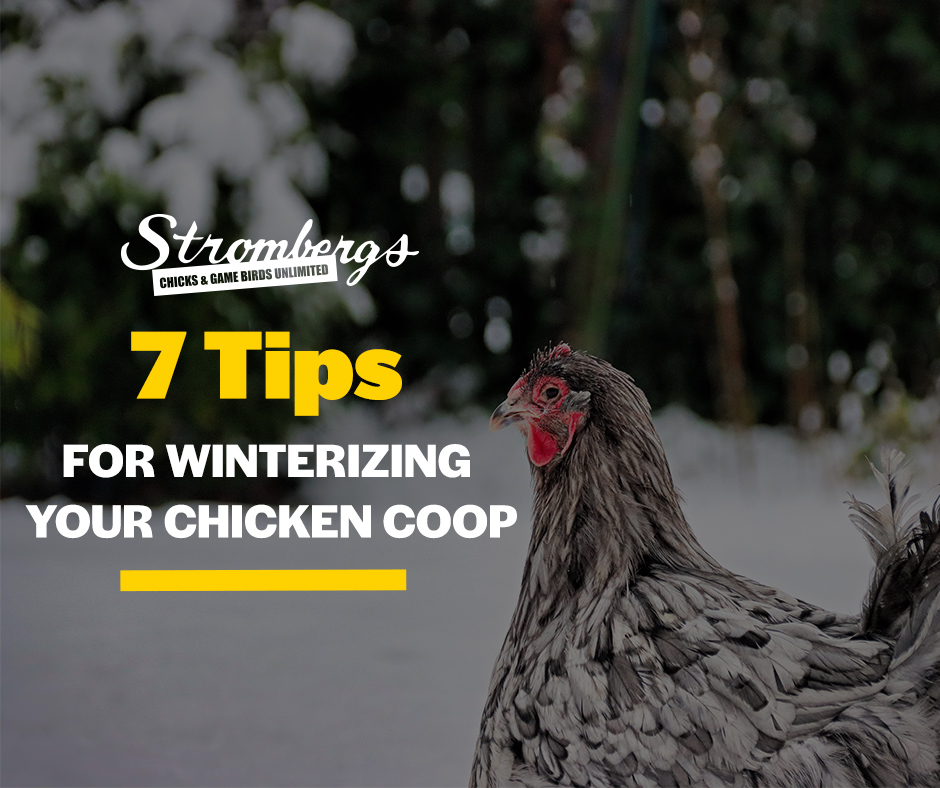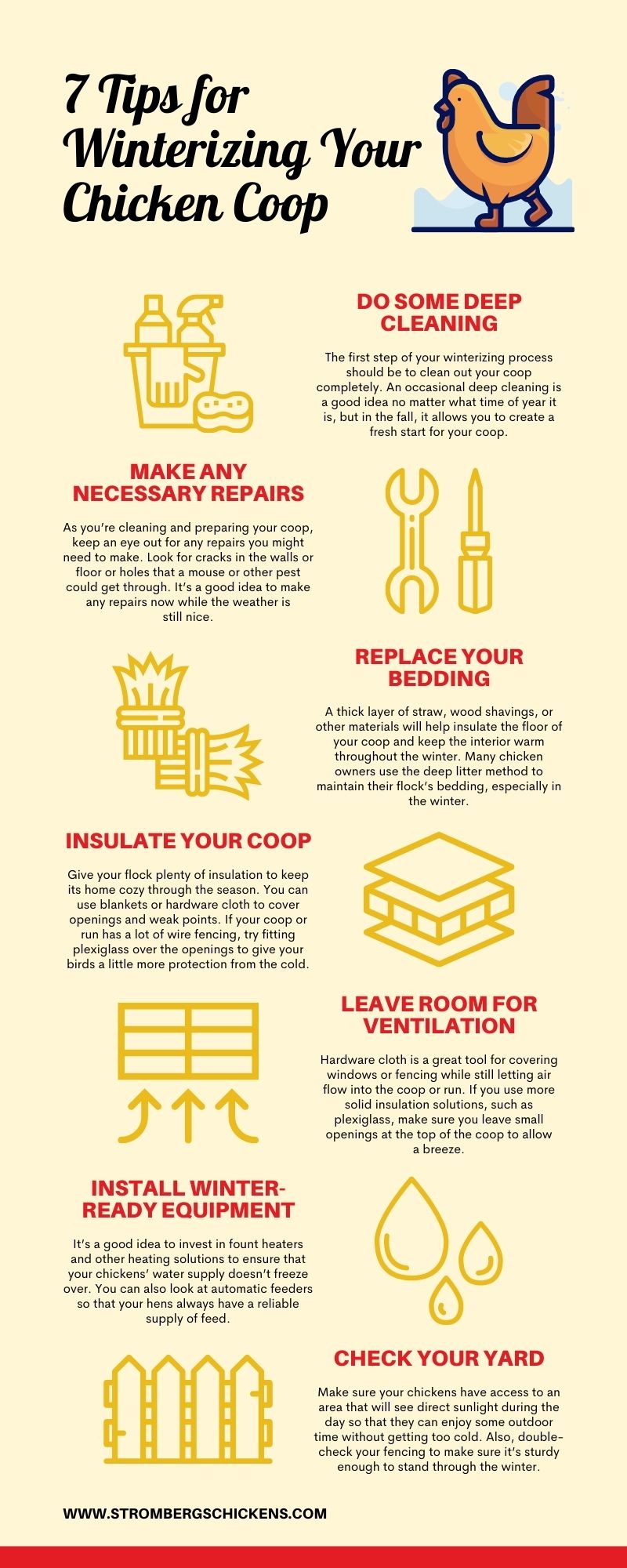7 Tips for Winterizing Your Chicken Coop
When winter comes around, a homeowner needs to make sure everything in their house and yard is ready for the freezing temperatures and potential snowfall. You should do the same for your backyard flock.
While chickens are hardy creatures that do a good job of regulating their temperature—even in the cold—there’s still a lot you can do to make the season easier for them. Your chicken coop, run, and the yard where your birds roam should be as secure and comfortable as possible by the time the cold weather sets in.
As you prepare your property for the coming season, make sure you take care of your flock with these tips for winterizing your chicken coop.

DO SOME DEEP CLEANING
The first step of winterizing should be cleaning out your chicken coops completely. An occasional deep cleaning is a good idea no matter what time of year it is, but it allows you to create a fresh start for your coop in the fall.
Remove all the bedding, and sweep out any leftover debris from the chicken coop and run. Scrape away any tough spots on the floor, walls, roosts, or other nooks and crannies of your coop. Scrub down everything, and let it dry thoroughly.
Also, take the time to clean out feeders, waterers, and nesting boxes so that all your equipment is fresh and ready for the winter season. It’s a good idea to do all of this in the fall when the weather is still decent so that you avoid any risk of water freezing in the coop as you clean.
MAKE ANY NECESSARY REPAIRS
As you clean and prepare your chicken coops, keep an eye out for any repairs you might need. Look for cracks in the walls, floor, or holes that a mouse or other pest could get through. It’s a good idea to make any repairs now while the weather is still nice.
Pay special attention to the roof and seams of your coop. Even if a predator can’t get in, little cracks and flaws in these areas can lead to a draft or snow getting into your coop, making your chickens’ home cold and miserable.
These repairs will also ensure an insulated coop throughout the cold winter months.
REPLACE YOUR BEDDING
You should give your flock a heavy layer of bedding in the winter. A thick layer of straw, wood shavings, or other materials will help insulate the floor of your coop and keep chickens warm throughout the winter.
Many chicken owners use the deep litter method to maintain their flock’s bedding, especially in the winter. Instead of frequently replacing the bedding in your coop, stir it regularly and add fresh bedding to the top.
This process creates an extra layer of insulation for your birds while also reducing the work you must do to keep the coop warm and clean over the winter.
INSULATE YOUR COOP
Speaking of insulation, make sure your coop is ready to face the harsh winds and freezing temperatures of winter. Give your flock plenty of insulation to keep its home cozy through the season.
You can use blankets or hardware cloth to cover openings and weak points. If your coop or run has a lot of wire fencing, try fitting plexiglass over the openings to give your birds a little more protection from the cold air.
This will help eliminate drafts, keep out snow and ice, and ensure your chickens have a warm place to sleep and hang out, even during extremely cold days.
LEAVE ROOM FOR VENTILATION
Remember that you don’t want to block airflow completely as you insulate your coop. Ventilation is just as important as insulation—no one wants excess humidity or musty air inside their home!
Hardware cloth is a great tool for covering windows or fencing while still letting air flow into the coop or run. If you use more solid insulation solutions, such as plexiglass, make sure you leave small openings at the top of the coop to allow a breeze. This will keep the coop dry and the air fresh.
More importantly, proper ventilation helps prevent moisture issues, such as mold growth or the spread of disease.
INSTALL WINTER-READY EQUIPMENT
Once the coop is ready for winter, it’s time to ensure all your equipment is, too. Investing in fount heaters with a heated base and chicken coop heaters is a good idea to ensure that your chickens’ water supply doesn’t freeze over. You can also look at automatic feeders so that your hens always have a reliable supply of feed.
These tools will make your job easier in the winter, especially if it’s a long journey from your home to your chicken coop. You’ll be grateful for anything that reduces the number of times you have to brave the cold and snow to get to your coop.
In addition to feeders and waterers, make sure you have warm nesting boxes for your hens. You can line them with nesting pads or extra bedding to make them extra cozy, even when the coop gets cold.
CHECK YOUR YARD
While many tips for winterizing your chicken coop revolve around the coop itself, you should also pay attention to the rest of your yard. Ensure your chickens have access to an area that will see direct sunlight during the day so they can enjoy some outdoor time without getting too cold.
Also, double-check your fencing to ensure it’s sturdy enough to withstand winter. Remember that your coop is even more attractive to predators during the winter, as it means access to free warmth and shelter and a free chicken dinner.
Repair any holes that predators can get through, and replace sections that might fall in a heavy snowfall. This will help ensure that your flock stays safe and warm throughout the season.
Winter is coming, so how are you preparing to keep warm air inside? Give us your best stories and advice in the comments below!


